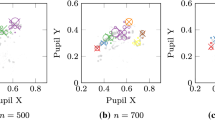Abstract
In this paper, a new algorithm for Data Streaming clustering is proposed, namely the SetClust algorithm. The Data Streaming clustering model focuses on making clustering of the data while it arrives, being useful in many practical applications. The proposed algorithm, unlike other streaming clustering algorithms, is designed to handle cases when there is no available a priori information about the number of clusters to be formed, having as a second objective to discover the best number of clusters needed to represent the points. The SetClust algorithm is based on structures for disjoint-set operations, making the concept of a cluster to be the union of multiple well-formed sets to allow the algorithm to recognize non-spherical patterns even in high dimensional points. This yields to quadratic running time on the number of formed sets. The algorithm itself can be interpreted as an efficient data structure for streaming clustering. Results of the experiments show that the proposed algorithm is highly suitable for clustering quality on well-spread data points.
Access this chapter
Tax calculation will be finalised at checkout
Purchases are for personal use only
Similar content being viewed by others
Notes
- 1.
These operations should be done online without traversing through all the elements.
- 2.
We need to calculate the new mean, standard deviation and the rest of the information in constant time.
- 3.
If we take advantage of the fact that only the last formed set can make instability, we can achieve an overall worst-case running time complexity of O(rd).
- 4.
As in the previous case, if we take advantage of the fact that only the last formed set can make instability, we can perform this operation in worst-case running time complexity of \(O(\alpha (r)rd)\), where \(\alpha \) is the inverse Ackerman function. For any practical situation, the function is never greater than 4.
References
Aggarwal, C.C., Reddy, C.: Data Clustering: Algorithms and Applications, 1st edn. Chapman & Hall/CRC (2013)
Aggarwal, C.C., Han, J., Wang, J., Yu, P.S.: A framework for clustering evolving data streams. In: Proceedings of the 29th International Conference on Very Large Data Bases, VLDB 2003, vol. 29, pp. 81–92. VLDB Endowment (2003)
Bifet, A., Holmes, G., Kirkby, R., Pfahringer, B.: MOA: massive online analysis. J. Mach. Learn. Res. 11, 1601–1604 (2010)
Campos, I., Leon, J.: Setclust. Zenodo, July 2019. https://doi.org/10.5281/zenodo.3270842
Cao, F., Ester, M., Qian, W., Zhou, A.: Density-based clustering over an evolving data stream with noise. In: Conference on Data Mining (SIAM 2006), pp. 328–339 (2006)
Cormen, T., Leiserson, C., Rivest, R., Stein, C.: Introduction to Algorithms, 3rd edn. MIT Press, Cambridge (2009)
Fränti, P., Sieranoja, S.: K-means properties on six clustering benchmark datasets. Appl. Intell. 48(12), 4743–4759 (2018). https://doi.org/10.1007/s10489-018-1238-7
Fränti, P., Virmajoki, O.: Iterative shrinking method for clustering problems. Pattern Recognit. 39(5), 761–775 (2006)
Galler, B.A., Fisher, M.J.: An improved equivalence algorithm. Commun. ACM 7(5), 301–303 (1964)
Jain, A., Dubes, R.: Algorithms for Clustering Data. Prentice-Hall Inc., Upper Saddle River (1988)
Karkkainen, I., Franti, P.: Dynamic local search for clustering with unknown number of clusters. In: Object Recognition Supported by User Interaction for Service, vol. 2, pp. 240–243 (2002)
Kranen, P., Assent, I., Baldauf, C., Seidl, T.: Self-adaptive anytime stream clustering. In: 2009 Ninth IEEE International Conference on Data Mining, pp. 249–258 (2009)
Muthukrishnan, S.: Data streams: algorithms and applications. Found. Trends Theor. Comput. Sci. 1(2), 117–236 (2005)
Rosenberg, A., Hirschberg, J.: V-measure: a conditional entropy-based external cluster evaluation measure. In: Proceedings of the 2007 Joint Conference on Empirical Methods in Natural Language Processing and Computational Natural Language Learning, pp. 410–420. EMNLP-CoNLL (2007)
Author information
Authors and Affiliations
Corresponding author
Editor information
Editors and Affiliations
Rights and permissions
Copyright information
© 2020 Springer Nature Switzerland AG
About this paper
Cite this paper
Campos, I., León, J., Campos, F. (2020). An Efficient Set-Based Algorithm for Variable Streaming Clustering. In: Lossio-Ventura, J.A., Condori-Fernandez, N., Valverde-Rebaza, J.C. (eds) Information Management and Big Data. SIMBig 2019. Communications in Computer and Information Science, vol 1070. Springer, Cham. https://doi.org/10.1007/978-3-030-46140-9_9
Download citation
DOI: https://doi.org/10.1007/978-3-030-46140-9_9
Published:
Publisher Name: Springer, Cham
Print ISBN: 978-3-030-46139-3
Online ISBN: 978-3-030-46140-9
eBook Packages: Computer ScienceComputer Science (R0)




